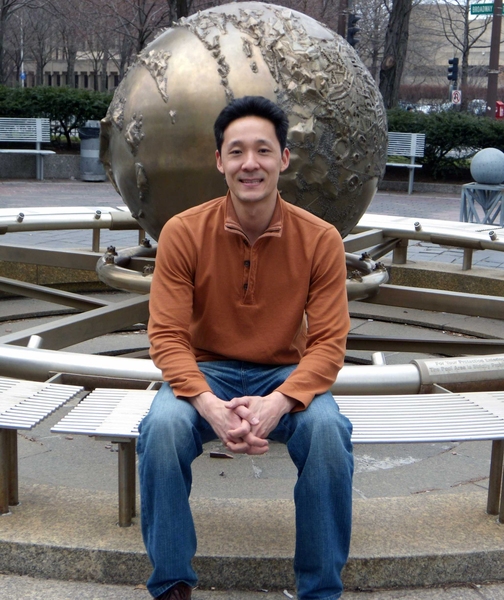System Design and Management student Eugene Kwak literally had a front-row seat in the ambitious private-sector space race.
Kwak, who is a member of the SDM class that entered in 2012, was the lead flight termination systems engineer for the Falcon 9, the first liquid-fuel spacecraft launched into orbit by a private company, Space Exploration Technologies (SpaceX). After launching from Cape Canaveral Air Force Station on June 4, 2010 (Kwak’s 31st birthday), the unmanned rocket completed two orbits around the earth.
As lead engineer for SpaceX, Kwak’s job was to design and monitor a system that would blow up or cut off the fuel supply of the Falcon 9 rocket in case it malfunctioned or went off course toward a heavily populated area.
“There was a technical, as well as a political aspect, since human safety is involved,” Kwak says. “I had to deal with multiple organizations, such as the Air Force, NASA and the FAA, among other entities.” Kwak spent many hours working with the Air Force to ensure that SpaceX met the thousands of technical requirements that allowed the company to launch from Cape Canaveral. During the launch, he was “on the console” in charge of subsystems and leading his team in running tests on the rocket. It was a job that definitely had its “stressful moments,” he admits.
Kwak, who has an MS in mechanical engineering from the University of Southern California, says he was humbled by the experience of being involved in the historic launch.
“The people I was surrounded by were truly brilliant. It was like a David vs. Goliath situation because we were competing against giants like Boeing and Lockheed Martin, in a market which has not been too kind to new entrants,” Kwak says.
SpaceX was recently chosen as one of Technology Review’s “50 Most Innovative Companies of 2012” and was awarded a $1.6 billion NASA contract to carry cargo to the International Space Station.
Kwak is a full-time, on-campus SDM student, and he will most likely not return to SpaceX when he graduates, because he plans to pursue a career in product management.
“I love technology and I want to apply it across different industries, not just aerospace,” he says.
The SDM program, which resides within the MIT Engineering Systems Division and is jointly offered by the MIT School of Engineering and the MIT Sloan School of Management, culminates in an SM in engineering and management and is just the right fit for Kwak, as he needs formal management training, but does not want to abandon engineering.
“I thought it was really important to bridge the gap between the business side and the engineering side and I thought this would be the best program for me,” he says.
Kwak is also a vice president of the MIT Sloan Asian Business Club and is a member of the Management Consulting Club.
Kwak, who is a member of the SDM class that entered in 2012, was the lead flight termination systems engineer for the Falcon 9, the first liquid-fuel spacecraft launched into orbit by a private company, Space Exploration Technologies (SpaceX). After launching from Cape Canaveral Air Force Station on June 4, 2010 (Kwak’s 31st birthday), the unmanned rocket completed two orbits around the earth.
As lead engineer for SpaceX, Kwak’s job was to design and monitor a system that would blow up or cut off the fuel supply of the Falcon 9 rocket in case it malfunctioned or went off course toward a heavily populated area.
“There was a technical, as well as a political aspect, since human safety is involved,” Kwak says. “I had to deal with multiple organizations, such as the Air Force, NASA and the FAA, among other entities.” Kwak spent many hours working with the Air Force to ensure that SpaceX met the thousands of technical requirements that allowed the company to launch from Cape Canaveral. During the launch, he was “on the console” in charge of subsystems and leading his team in running tests on the rocket. It was a job that definitely had its “stressful moments,” he admits.
Kwak, who has an MS in mechanical engineering from the University of Southern California, says he was humbled by the experience of being involved in the historic launch.
“The people I was surrounded by were truly brilliant. It was like a David vs. Goliath situation because we were competing against giants like Boeing and Lockheed Martin, in a market which has not been too kind to new entrants,” Kwak says.
SpaceX was recently chosen as one of Technology Review’s “50 Most Innovative Companies of 2012” and was awarded a $1.6 billion NASA contract to carry cargo to the International Space Station.
Kwak is a full-time, on-campus SDM student, and he will most likely not return to SpaceX when he graduates, because he plans to pursue a career in product management.
“I love technology and I want to apply it across different industries, not just aerospace,” he says.
The SDM program, which resides within the MIT Engineering Systems Division and is jointly offered by the MIT School of Engineering and the MIT Sloan School of Management, culminates in an SM in engineering and management and is just the right fit for Kwak, as he needs formal management training, but does not want to abandon engineering.
“I thought it was really important to bridge the gap between the business side and the engineering side and I thought this would be the best program for me,” he says.
Kwak is also a vice president of the MIT Sloan Asian Business Club and is a member of the Management Consulting Club.






